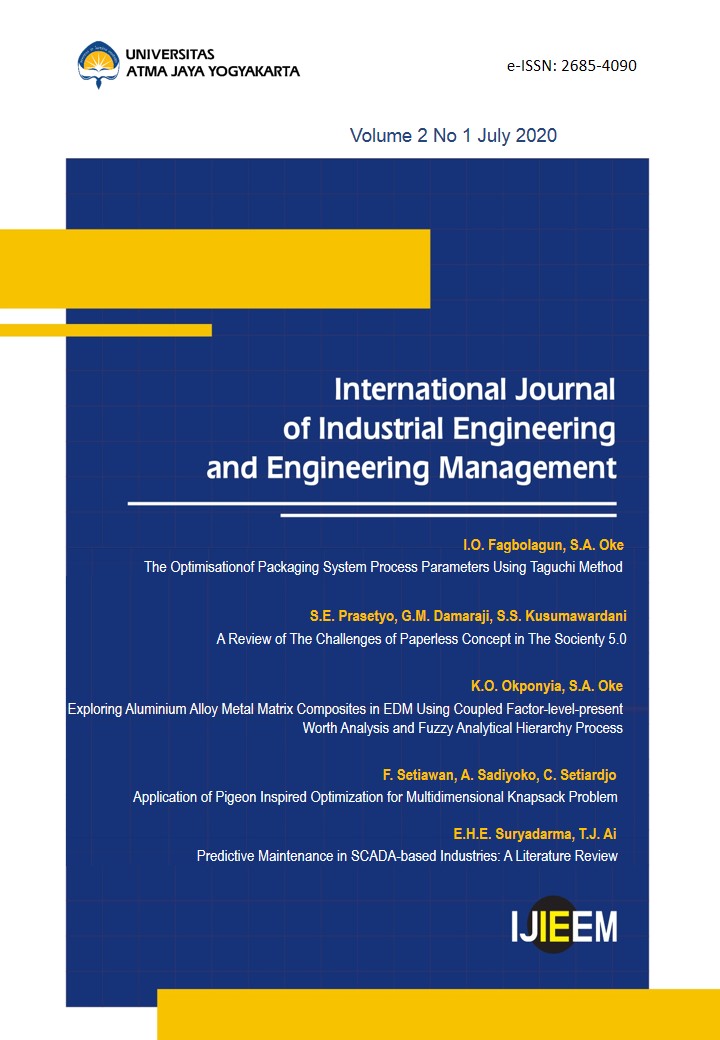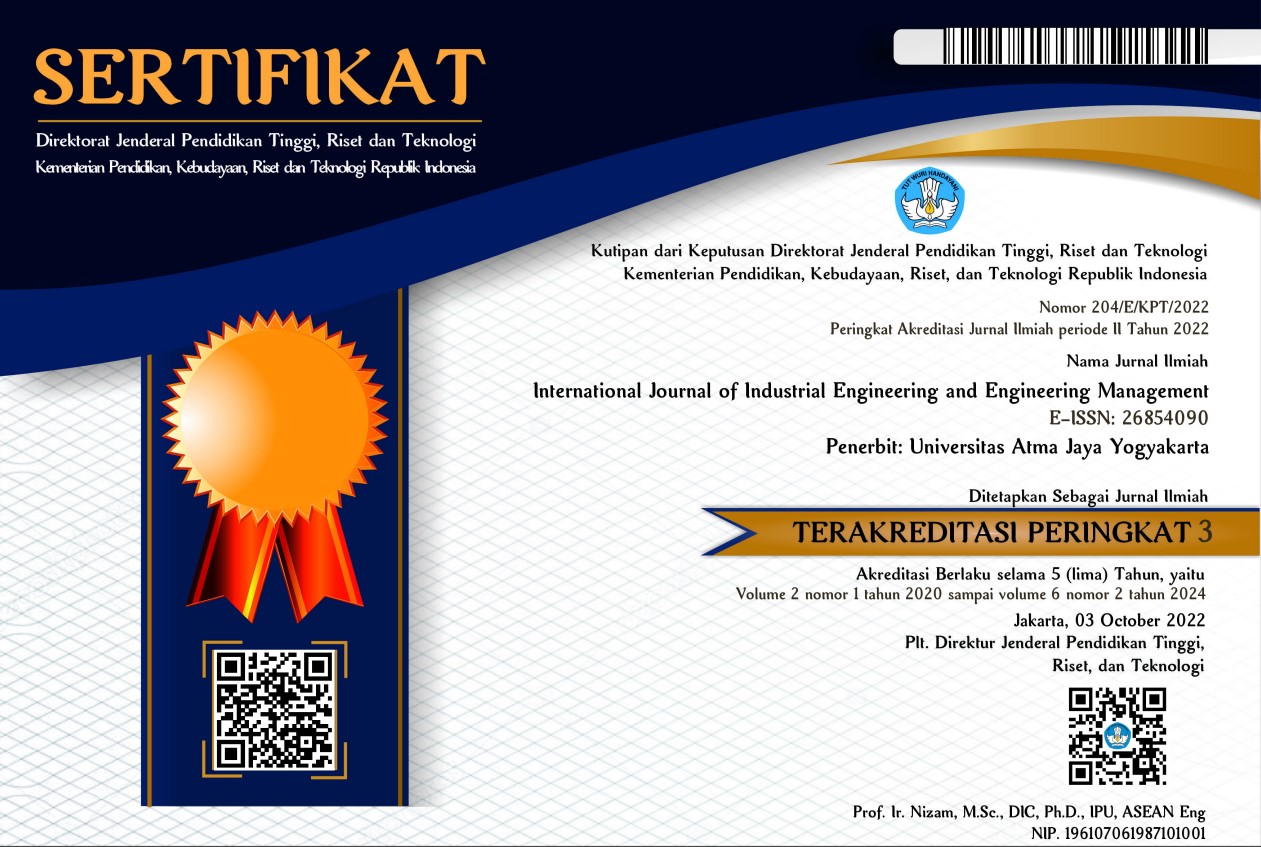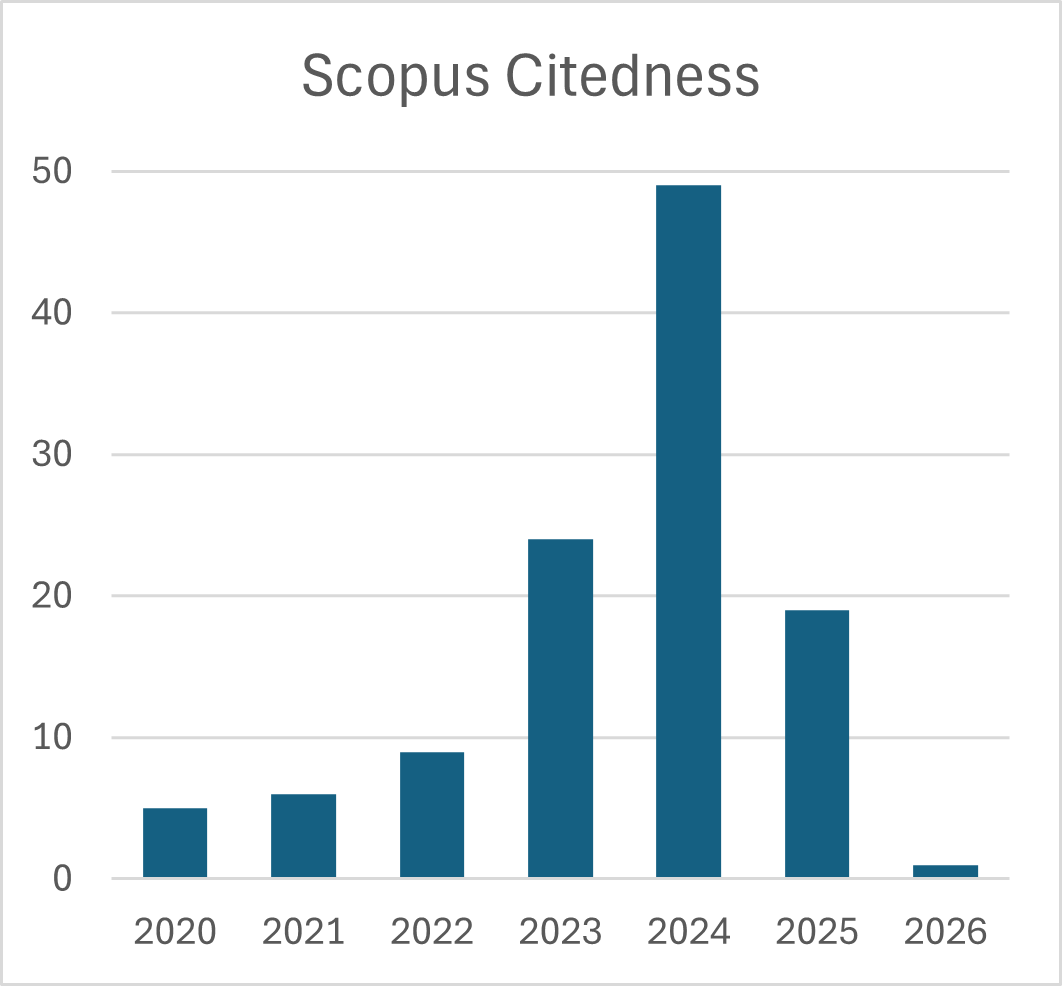A Review of The Challenges of Paperless Concept In The Society 5.0
DOI:
https://doi.org/10.24002/ijieem.v2i1.3755Keywords:
Paperless, Green Computing, Society 5.0, DigitalizationAbstract
The world will start a new era of society where technology and humans can collaborate to solve social problems. Many countries have ridden into the 4.0 era in the industrial revolution. In reality, Japan began to introduce Society 5.0, where the concept was the answer to the industrial revolution 4.0. Society 5.0 applies the human-centered concept based on information technology. In fact, there has been no in-depth study of the advantages and challenges of implementing paperless in various fields. The purpose of this paper is to review the challenges and the advantages of the paperless concept using Narrative Literature Review to provide an objective analysis of the paperless concept. The objects research discussed including industry/manufacturing, education, medical, and government. This paper provides an in-depth study and analysis of the paperless concept's advantages and challenges related to hardware and software maintenance, data security and reliability, human resources technical skills, social interaction, and disaster recovery strategy.
References
Agarwal, S., Basu, R. S., & Nath, A. (2014). Green Computing and Sustainable Environment – Introduction of E-documents and Replacement of Printed Stationeries. International Journal of Innovative Research in Information Security (IJIRIS), 1(5), 46–53.
Alzahrani, A., Alzahrani, A., Arfaj, F. K. Al, Almohammadi, K., & Alrashidi, M. (2015). AutoScor: An Automated System for Essay Questions Scoring. International Journal of Humanities Social Sciences and Education (IJHSSE), 2(5), 182–187.
Amandangi, D. P., Mulyati, Y., & Prasetyo, S. E. (2020). Web-Based Learning Design on Folklore Text for Intermediate Indonesian Language for Foreign Speakers (BIPA). The 4th International Conference on Education and Multimedia Technology, 150–155.
Anwar, M. (2013). Green Computing and Energy Consumption Issues in the Modern Age. IOSR Journal of Computer Engineering, 12(6), 91–98.
Arkorful, V., & Abaidoo, N. (2014). The role of e-learning, the advantages, and disadvantages of its adoption in Higher Education. Int. J. of Education and Research, 2(12), 397–410.
Ashby, L. (2001). Extension’s Progress in the Paperless Revolution: Balancing Digital and Paper. Journal of Extension, 49.
Asia, B. M. C. (2015). Russia: Man Convicted in Kabarda-Balkaria for Hacking Government Website. London: BBC Worldwide Limited.
Astola, P., Rodrígueza, P., Botanab, J., & Marcosb, M. (2017). A paperless based methodology for managing Quality Control. Application to a I+D+i Supplier Company. Procedia Manufacturing, 13, 1066–1073.
Bailey, A. (2012). Establishing Standards for the Paperless Office. CPA Practice Advisor, 22(8), 32–33.
Calvo, M., Carnicer, A., Cuadros, J., Martori, F., Miñarro, A., & Serrano, V. (2019). Computer-Assisted Assessment in Open-Ended Activities through the Analysis of Traces: A Proof of Concept in Statistics with R Commander. Journal of Mathematics, Science and Technology Education, 15(9), 1–13.
Chiang, H.-H., Chen, W.-M., Chao, H.-C., & Tsai, D.-L. (2019). A virtual tutor movement learning system in eLearning. Multimed Tools Appl, 78(2).
Conole, G., & Warburton, B. (2005). A review of computer-assisted assessment. Alt-J Research in Learning Technology, 13(1), 17–31.
Cooper, C., & Caroline Erolin. (2018). The optic pathway: the development of an eLearning animation. Journal of Visual Communication in Medicine, 41, 64–70.
Dalpiaz, F., Giorgini, P., & Mylopoulos, J. (2013). Adaptive socio-technical systems: a requirements-based approach. Requirements Engineering, 18(1), 1–24.
Davis, F. D., & Yi, M. Y. (2004). Improving Computer Skill Training: Behavior Modeling, Symbolic Mental Rehearsal, and the Role of Knowledge Structures. Journal of Applied Psychology, 89(3), 509–523.
Dhumne, P. K. M. (2017). Paperless Society in Digital Era. International Journal of Library and Information Studies, 7(64344), 317–319.
Dykstra, R. H., Ash, J. S., Campbell, E., Sittig, D. F., Guappone, K., Carpenter, J., Richardson, J., Wright, A., & McMullen, C. (2009). Persistent Paper: The Myth of “Going Paperless.” AMIA 2009 Symposium Proceedings.
Ebrahim, Z., & Irani, Z. (2005). E-government Adoption: Architecture and Barriers. Business Process Management Journal, 11(5), 589–611.
Europe, S. C. (2010). Paperless Solution for Paper Industry.
Frear, H. (2014). Fear of Filing? EDM can help with Paper Overload and Building Customer Relationships. Trade Publication, 35(4), 87–89.
Ghapanchi, A. H., Wohlin, C., & Aurum, A. (2014). Resources contributing to gaining competitive advantage for open source software projects: An application of resource-based theory. Int. J. of Project Management, 32(1), 139–152.
Gierl, M., & Lai, H. (2015). Using Automated Processes to Generate Test Items And Their Associated Solutions and Rationales to Support Formative Feedback. Interaction Design and Architecture(s) Journal, 9–20.
Hamadah, S., & Aqel, D. (2019). A Proposed Virtual Private Cloud-Based Disaster Recovery Strategy. IEEE Jordan International Joint Conference on Electrical and Information Technology (JEEIT).
Hattingh, M. (2001). The features and impact of the paperless office, with specific reference to the City of Johannesburg. SA Journal of Information Management, 3(3/4).
Hlusko, D. L., Pahoulis, E., & Branson, L. (1998). Cut Training Costs with Computer-Based Tutorials. Nursing Management, 29(11), 31–33.
Huang, H.-C., Zhang, Z.-K., Cheng, H.-W., & Shieh, S. W. (2017). Web Application Security: Threats, Countermeasures, and Pitfalls. IEEE Computer Journal, 50(6), 81–85.
Ivanov, D., Dolgui, A., & Sokolov, B. (2019). The impact of digital technology and Industry 4.0 on the ripple effect and supply chain risk analytics. International Journal of Production Research, 47(3), 829–846.
Joia, L. A., & Vinhais, J. C. dos S. (2017). From closed source to open source software: Analysis of the migration process to Open Office. Journal of High Technology Management Research, 28(2), 261–272.
Jun-Feng, T., Jia-Yao, Z., & Rui-Zhong, A. Du. (2018). Date Hierarchical Storage Strategy for Data Disaster Recovery. IEEE Access, 10, 1–9.
Khan, M. A., & UrRehman, F. (2013). An Extendable Open Source Architecture of e-Learning System. Fourth International Conference on E-Learning ‘Best Practice in Management, Design, and Development of e-Courses: Standards of Excellence and Creativity.
Kim, M., Zimmermann, T., DeLine, R., & Begel, A. (2015). The Emerging Role of Data Scientists on Software Development Teams. In Microsoft Research Technical Report.
Lia, Y., Huanga, J., Ikusanc, A., Mitchellb, M., Zhanga, J., & Daic, R. (2019). ShellBreaker: Automatically detecting PHP-based malicious web shells. Computers & Security, 87(1), 1–11.
Lim, S. (2012). Data Warehouse Untuk Pengelolaan Penjualan Pada Pt. Lippo Karawaci, Tbk. Jurnal Ilmiah SISFOTENIKA, 2(1), 61–70.
Liu, M., Calvo, R. A., Aditomo, A., & Pizzato, L. A. (2012). Using Wikipedia and conceptual graph structures to generate questions for academic writing support. IEEE Transactions on Learning Technologies, 5(3), 251–263.
Liu, M., Rus, V., & Liu, L. (2018). Automatic Chinese Multiple Choice Question Generation Using Mixed Similarity Strategy. IEEE Transactions on Learning Technologies, 11(2), 193–202.
Martín-Blas, T., & Serrano-Fernández, A. (2008). The role of new technologies in the learning process: Moodle as a teaching tool in Physics. Computers & Education. 52(1), 35–44.
Maulana, A. R. (2019). KANSA: High Interoperability e-KTP Decentralised Database Network Using Distributed Hash Table. Telkomnika, 17(3), 1360–1366.
Micheloni, R. (2017). Solid-State Drive (SSD): A Nonvolatile Storage System. Proceedings of the IEEE.
Middleton, M., Bradford, C., Frantzis, J., Ambler, A., Sisson, T., Montgomerie, D., & Martin, J. M. (2009). Paperless and paper-based processes in the modern radiotherapy department. Radiography, 15(4), 300–305.
Munir, S. (2018). The Impact of using Gadgets on Children. Journal of Depression and Anxiety, 07(01), 1–3.
Murthy, N. (2013). Paperless organization. Asia Pacific Journal of Marketing & Management Review, 2(9), 87–97.
Narayanan, R. L., & Ibe, O. (2012). A joint network for disaster recovery and search and rescue operations. Computer Networks, 56(14), 3347–3373.
Narayanan, R., Rangan, V. P., Gopalakrishnan, U., & Hariharan, B. (2019). Multiparty gaze preservation through perspective switching for interactive elearning environments. Multimedia Tools and Applications, 78(1), 1–34.
Nursalim, M. (2014). Optimalisasi Pelayanan Publik Dalam Pelaksanaan e-KTP Guna Memperkokoh Ketahanan Wilayah (Studi di Kelurahan Kalibaru Kecamatan Cilodong Kota Depok). J. Ketahanan Nasional, 20(1), 27–38.
Oni, S., Berepubo, K. A., Oni, A. A., & Joshua, S. (2019). E-government and the Challenge of Cybercrime in Nigeria. 2019 Sixth International Conference on EDemocracy & EGovernment (ICEDEG).
Oztekin, A., Delen, D., Turkyilmaz, A., & Zaim, S. (2013). A machine learning-based usability evaluation method for eLearning systems. Decision Support Systems, 56(1), 63–73.
Parviainen, P., Tihinen, M., Kääriäinen, J., & Teppola, S. (2017). Tackling the digitalization challenge: How to benefit from digitalization in practice. International Journal of Information Systems and Project Management, 5(1), 63–77.
Podichetty, V. K., & Penn, D. (2004). The Progressive Roles of Electronic Medicine: Benefits, Concerns, and Costs. American Journal of the Medical Sciences, 328(2), 94–99.
Prasetyo, S. E., Adji, T. B., & Hidayah, I. (2020). Automated Item Generation: Model and Development Technique. 7th International Conference on Information Technology, Computer, and Electrical Engineering (ICITACEE), 64–69.
Pribadi, F. S., Adji, T. B., Permanasari, A. E., Mulwinda, A., & Utomo, A. B. (2017). Automatic short answer scoring using words overlapping methods. AIP Conference Proceedings, 1818 (March 2017).
Ramalingam, V. V., Pandian, A., Chetry, P., & Nigam, H. (2018). Automated Essay Grading using Machine Learning Algorithm. Journal of Physics: Conference Series, 1000(1).
Rosalee Carr, M. (2005). An analysis of the feasibility of a paperless environment – the case of the Mona School of Business. Management of Environmental Quality: An International Journal, 16(4), 286–290.
Rumpa, L. D., Lembang, S. T., Vonny, S., Salu, B., & Allo, M. D. G. (2017). Towards Paperless Education : A Preliminary Research Applying E-Learning on Engineering Education. The 1st International Conference on EFL Teaching and Research.
Safitri, R. (2018). Law on Electronic Information and Transactions for Universities. Jurnal Sosial & Budaya Syar-I., 5(3).
Salomi, M. J. A., & Maciel., R. F. (2017). Document Management and Process Automation in a Paperless Healthcare Institution. Technology and Investment, 08(03), 167–178.
Samtani, S., Chinn, R., Chen, H., & Nunamaker, J. F. (2017). Exploring Emerging Hacker Assets and Key Hackers for Proactive Cyber Threat Intelligence. Journal of Management Information Systems, 34(4), 1023–1053.
Saputra, R. W. (2016). A Survey of Cyber Crime in Indonesia. 2016 International Conference on ICT For Smart Society.
Scaife, N., Carter, H., Traynor, P., & Butler, K. R. B. (2016). CryptoLock (and Drop It): Stopping Ransomware Attacks on User Data. IEEE 36th International Conference on Distributed Computing Systems.
Shonfeld, M., & Tal, H. M. (2017). The Voice of Teachers in A Paperless Classroom. Int. Disciplinary Journal of e-Skills and Lifelong Learning, 13, 185–196.
Stephens, G. L., Kahn, B. H., & Richardson, M. (2016). The Super Greenhouse Effect in a Changing Climate. Journal of Climate, 29(15), 5469–5482.
Suhana, M. (2017). Influence of Gadget Usage on Children’s Social-Emotional Development. International Conference of Early Childhood Education (ICECE 2017).
Teeter, S., Madsen, S. R., Hughes, J., & Eagar, B. (2001). The Perceptions and Experiences of Students in a Paperless Accounting Class. The Journal of Effective Teaching, 7(1), 15–30.
Whitworth, B. (2019). The Social Requirements of Technical Systems. Handbook of Research on Socio-Technical Design and Social Networking Systems.
Yaqooba, I., Ahmeda, E., Rehmanb, M. H. ur, Ibrahim, A., Ahmeda, A., Al-garadic, M. A., Imrand, M., & Guizanie, M. (2017). The rise of ransomware and emerging security challenges in the Internet of Things. Computer Networks, 129, 444–458.








